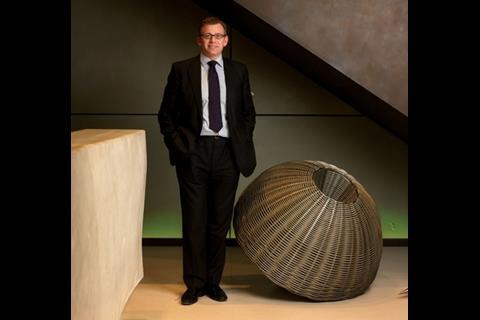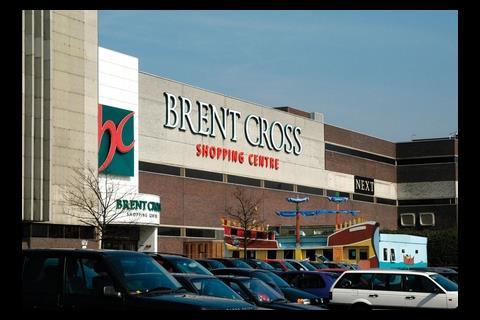Hammerson doesn’t like cosy relationships and obliging suppliers. It wants designers and builders who will kick back, come up with alternative suggestions and generally keep its creative juices flowing.
Jon Emery once berated a team from Cyril Sweett for being “a bunch of white, middle-aged men”. He compared the QSs to his own team – a vibrant mix of sexes, ages and colours. This eclectic crew reflects how far Hammerson has come in its transformation from a staid developer of shopping malls such as Brent Cross in north London, to a pioneer of glorious mixed-use urban regeneration schemes.
The next place in for the Hammerson treatment is Swansea. In January the firm was chosen to redevelop large areas of the town – and it will be spending a lot of money to do it. Hammerson already has £1bn of work on site and, undaunted by the credit crunch, it is confident it will spend another £1bn in the next three years – not including Swansea.
So, this is a client with money to spend and exciting projects in hand, but if you want to work with it your face must fit. Indeed, in the two years since he lambasted Cyril Sweett, Emery says the consultant has changed a lot. “Now we’re working with several women from its offices and I think they’re fantastic.”
Change, diversity and innovation are big themes for Emery. “You can’t only work with people like you. You need new ideas, young ideas, rather than using the same old people all the time. You have got to keep fresh,” he says. It’s perhaps a surprising outlook considering Emery, 42, has worked for Hammerson for 19 years.
Founded in 1942, Hammerson’s specialities are offices and retail projects, but recently it has been mixing the two with residential elements to create complex and exciting schemes. It teams up with residential developers to do this, for example, a joint venture with Urban Splash gave birth to Birmingham’s Bullring shopping centre in 2003. The two are pairing up again on Swansea, which looks set to be similarly flamboyant. The £1bn scheme will cover 30 acres in the heart of the city and include 600,000ft2 of retail space, 1,000 residential units, hotels, offices and leisure facilities.
Hammerson has five major projects currently on site in the UK, three of which are retail-led extravaganzas in the Bullring mould. These include the £245m Cabot Circus retail-led scheme in Bristol, which Hammerson is developing through a joint venture with Land Securities. Tenants in the 1 million ft2 scheme include House of Fraser.
In the pipeline and coming on stream before Swansea are two other giant retail-led schemes: the New Retail Quarter in Sheffield and Eastgate & Harewood Quarters in Leeds, which are worth £600m apiece and due on site in 2008 and 2009, respectively. Hammerson is also planning to start building the £650m Bishops Place in Shoreditch, east London, to a design by Foster + Partners. Cabe recently attacked the scheme for being “too dense” but Emery shrugs this off. “The planning application is out and we’re waiting for the response,” he says.
Dense or not, these projects are a far cry from Hammerson’s shopping malls of the seventies and, as Emery says, they offer “interesting” work for contractors, consultants and architects alike. Interesting is one of his favourite words.
So how do you get to work with Hammerson? First, understand that Emery loves architecture – he is currently designing his own house – and his thing is giving unknown practices big breaks.
You can’t only work with people like you. You need new ideas, young ideas, rather than using the same old people all the time. You have got to keep fresh
Jon Emery
Take Gollifer Langston, a 12-person practice, with a turnover of about £500,000 to £1m. Andy Gollifer, its director, had never even spoken to a big developer when he got a call out of the blue from Emery, who had just driven past one of the firm’s schemes, a community media centre in Islington, north London, called Platform1.
“An hour later he was here in our office,” says Gollifer. Emery asked the firm to enter a competition to design a residential block for its Highcross scheme in Leicester, which it won. Now it is designing a multistorey car park and the public realm for the scheme.
Emery’s penchant for using untested architects is great news for new practices, but for the rest of the project team it can be difficult. Still, everyone we spoke to agreed it makes things more interesting. Hammerson gets small practices to work alongside bigger firms, such as Building Design Partnership, which handle the masterplan. John Wakes, head of retail at BDP, says the approach “makes it more challenging because there are more ideas around and more questioning of ideas”. For example, while BDP may have planned a civic building to be clad in stone, a new practice might argue that it could be clad in steel. “This could lead to us having to change the building next door,” says Wakes. “On a Hammerson scheme you don’t quite know what’s going to happen next.”
Similar principles apply to Hammerson’s approach to contractors. It uses large firms for big projects – mainly Bovis Lend Lease, Sir Robert McAlpine and, to a lesser extent, Balfour Beatty and Laing O’Rourke. On smaller projects it uses regional contractors, for example, a firm called Jessops is building the residential element of Highcross in Leicester.
Your size might not be an issue but Hammerson does insist that you can think quickly and adapt. Emery says: “The pace of change within our business has been fast. We like contractors and consultants who can keep up. We want people who don’t presume that whatever we bought last time we want this time.”
And he doesn’t mind if you pick a fight with him. “We want people to stand up to us. We are quite strong and we have done this lots of times, so I suppose that can be quite intimidating. The people who work best with us are the people that have the confidence to make proposals that test us. We want to really push things”
At the same time, be ready to play a long game. BDP’s Wakes says working on such big schemes “requires a lot patience”. Take Swansea: BDP worked on the masterplan for nine months before the Hammerson/Urban Splash team won the contract in January. Emery says: “The scope is yet to be agreed. We need to discuss it with the council
and the stakeholders. It could take another three to four years to reach the compulsory purchase enquiry.” And then there will be another three to four years of construction, by the end of which, you’ll be working flat out. Emery says: “We invite people to think very carefully about taking holidays in the last six months of a project. It does become all-consuming.”
John Emery’s CV
Education
- Stamford School, Lincolnshire Trent Polytechnic
- University of South London
- Henley Management College: MBA 1992-94
Employment
- Joined Hammerson in 1989
- Appointed managing director of all development and construction in the UK in January 2007
Key projects
- The Oracle, Reading: 750,000ft2 retail and leisure-led regeneration, which won British Council of Shopping Centres and International Council of Shopping Centres Best Centre Awards in 1999
- Bullring, Birmingham: £750m retail-led regeneration. Has won more than 50 awards.
Who Hammerson works with
Contractors
Sir Robert McAlpine, Bovis Lend Lease, Balfour Beatty, Laing O’Rourke, plus regional contractors such as Jessops
Architects
Allford Hall Monaghan Morris, Arup, BDP, Foreign Office Architects, Foster + Partners, Future Systems, Gollifer Langston, Hawkins\Brown, O’Donnell + Tuomey, Pick Everard Architects, Stiff+Trevillion Architects
QSs and project managers
Davis Langdon, Cyril Sweett, Gardiner & Theobald, Second London Wall and more recently EC Harris and Gleeds
Sustainability specialists
Arup, Atelier Ten, Building Design Partnership, Cyril Sweett, Battle McCarthy
Emery on …
… what he likes from architects
“I am impressed by architects that question the brief. People who ask ‘why doesn’t this building incorporate the one next door?’ I’m looking for clever people who aren’t just focusing on aesthetics.
“The work of small practices is significantly better than larger firms. The passion, quality and speed are so different and they are a bit off the wall. The value someone can bring is more important than the fee differential.”
… quantity surveyors
“We prefer to use the same firm for QS and project management as it means one less interface, but we do use project management specialist Second London Wall on city offices because it offers a unique service, with commitment from certain individuals.
“We set up our projects in stages so there are points at which we can pause and ask if we have the right team and change it if necessary.”
… sustainability
“Using the same consultants all the time means they don’t challenge us, particularly on sustainability. We’ve really had to get them to wake up to our aspirations and have brought in many new people in the past year. ‘Sustainability consultant’ is now a role on our teams. All our projects will be BREEAM ‘excellent’ from now on. Bristol will be our first excellent-rated shopping centre.
… procurement
We are nervous about construction management – we prefer the builder to take the risk. We haven’t procured a project in two years so we haven’t felt the effects of the busy market and price escalation, but I believe this will change. The UK market will cool and I’m hopeful this will cut prices and staff churn rate. When selecting the project team we use quite a formal process. Everything is competitively tendered. Regional strength is important and we try to make sure every shortlist has at least three firms on it.”
What they say about Hammerson
"The use of small architectural practices alongside us is a challenge because the design keeps changing, but it makes for a really vibrant project"
John Wakes, head of retail, BDP
"Ambition and innovation sit at the centre of their offering. Collaboration is important to us at every stage and Hammerson “gets” this"
Tony Douglas, Laing O’Rourke’s chief operating officer
"It is not just a developer – it is an intelligent client. Some people come to us with an unachievable design or unrealistic budget, but not Hammerson"
Mike Peasland, Balfour Beatty
"It knows exactly how much it will spend and who it wants. It is interested in personalities: if it liked you when you were at Cyril Sweett, it’ll follow you to Davis Langdon"
QS source
Postscript
This article first appeared in Building dated 22/02/08 under the title "Anyone fancy a fight?"
































2 Readers' comments